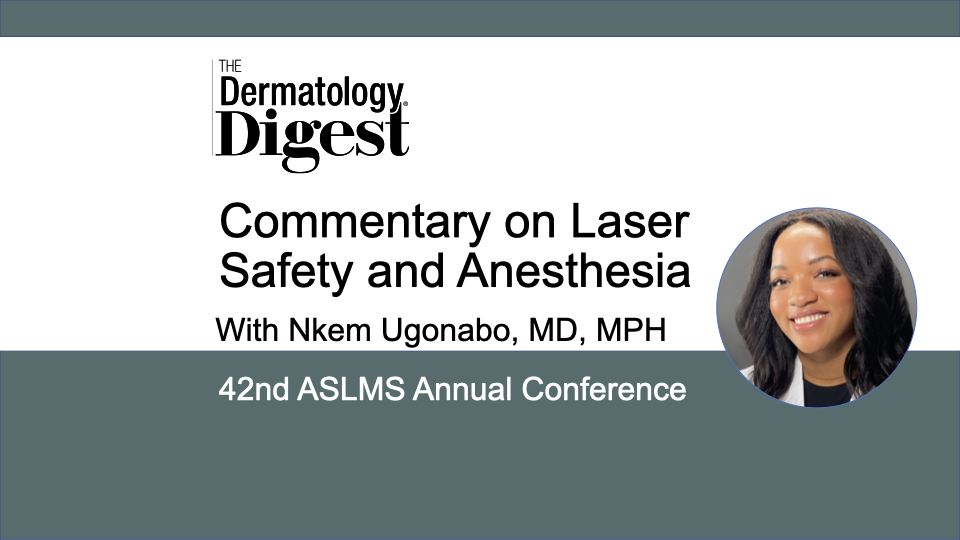Dr. Nkem Ugonabo discusses topical and inhaled anesthesia, including benefits, risks, and toxicity management.
Nkem Ugonabo, MD, MPH, Board-Certified Dermatologist, UnionDerm, New York City
“Local anesthesia plays a critical role in procedural dermatology. Many of the procedures that we do in clinic, whether cosmetic, laser, etc., can be very painful for patients,” said Nkem Ugonabo, MD, MPH, who presented on safety considerations with anesthesia during the “Laser Safety and Anesthesia” session at ASLMS 2023 in Phoenix, Arizona.
“It’s because of local anesthesia that we’re able to treat these patients in the office with much less pain and discomfort.”
But commonly used anesthesia options in dermatology, including topical and inhaled anesthetics, are not without risk, said Dr. Ugonabo.
“In fact, there have been deaths reported as a result of topical anesthesia applications. One in particular was a young woman in her 20s who had applied topical anesthetic prior to a laser treatment at home. She then occluded it for an unknown period of time before her appointment. She unfortunately fell into a coma and passed away.”
Dr. Ugonabo said she felt it was important to address safe use of topical and inhaled anesthetic options because they’re not talked about as much at meetings.
Safe Use of Topical Anesthetic
Lidocaine is the most common topical anesthetic in dermatology, whether applied alone or in combination with other ingredients, said Dr. Ugonabo.
“Part of that is because it is associated with a decrease in allergic reactions and can be compounded pretty easily into higher concentrations.”
Many dermatologists use higher concentrations. For example, many might use 30% lidocaine and petrolatum, she said.
“The advantage of topicals is that you can anesthetize the patient without distorting the anatomy prior to treatment, and it is great for patients who are needle-phobic because it doesn’t require any injections.”
However, there is systemic absorption and blood levels can be affected by the amount of area to which the topical is applied. Other factors that impact absorption include the strength of the anesthetic, age and weight of the patient, duration of time that it was applied, and whether or not occlusion was used, said Dr. Ugonabo.
“There are FDA approved guidelines with respect to the amount of FDA approved topical anesthetics, such as Emla [lidocaine 2.5% and prilocaine 2.5%, Actavis Pharma].”
However, Dr. Ugonabo emphasized, compounded anesthetics are not FDA regulated and have significant variability in terms of product quality, packaging, and dosing accuracy.
“So, you have to be careful with compounded anesthetics because it’s not always clear what you’re getting.”
Two things that dermatologists have to be particularly cautious about when using local anesthetic options are application to a large body surface area and occlusion, she said.
Topical Lidocaine Toxicity
It is important that dermatologists know how to manage lidocaine toxicity and are prepared for serious side effects, according to Dr. Ugonabo.
“[Lidocaine] can result in serious cardiovascular and neurological injuries including death, so it’s important for us, as dermatologists, to be equipped in our offices to respond to possible toxicity symptoms. These include lightheadedness, numbness, etc. We have to be able to maintain the patient’s airway, place them in the right position, give medications as necessary, and of course get that patient medical attention as soon as they have been stabilized.”
Dr. Ugonabo said that expert consensus on toxicity with topical lidocaine includes these recommendations:
- Only apply it to intact skin
- Avoid contact with eye mucosa
- Use precaution with compounded topicals
- Be careful of occlusion because that is going to increase the absorption
“You may want to consider having a standardized amount of topical for the office so that if it is not you personally that is actually administering the topical, staff have a maximum amount that they would apply to each patient.”
Nitrous Oxide Safety
Nitrous oxide is the most common inhaled option—widely available for more than 100 years. Historically, dentists have primarily used it but now dermatologists have adapted it to practice as well, said Dr. Ugonabo.
“Part of that is because it has quick onset and recovery. It also has a very high patient satisfaction rate. That’s because it tends to be very helpful in taking patients’ minds off of what’s going on and helps them get through procedures that might not have been as easy without it.”
The most common adverse event with nitrous oxide is mood lability, including laughter, anxiety, and disassociation. Nausea or dizziness are other possible adverse events, said Dr. Ugonabo.
“Many of the studies that we talked about during this presentation show that these adverse events for the most part were mild and transient, so it does seem to be safe overall.”
But it is important to know that pregnancy is a significant, absolute contraindication for nitrous oxide, and not just for the person receiving it but also for providers and staff who might be pregnant, she said.
“Speaking of pregnancy, we did review some things to keep in mind with anesthetics in general. So, in addition to the nitrous oxide contraindication, lidocaine is category B, meaning it is safe to use during pregnancy. Epinephrine is category C, so that should be limited.”
Most experts recommend reserving procedures in pregnant patients for when the procedures are an urgent medical necessity, said Dr. Ugonabo.
“Most pregnancy experts recommend postponing the procedure, if possible, until after pregnancy or at least until the second semester when organogenesis is complete.”


